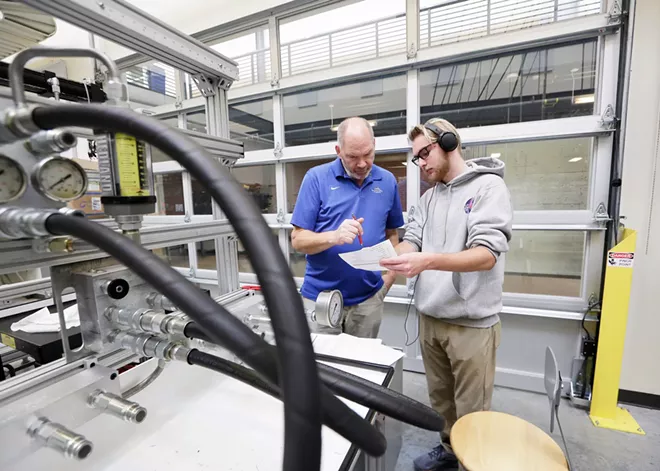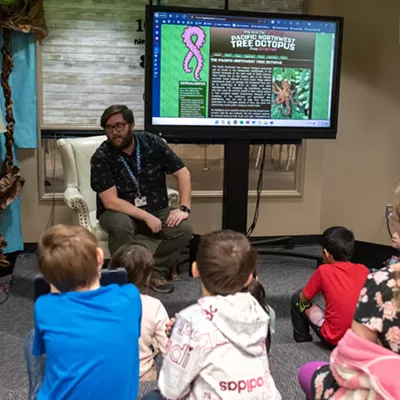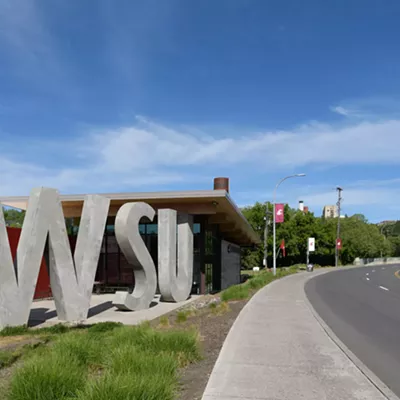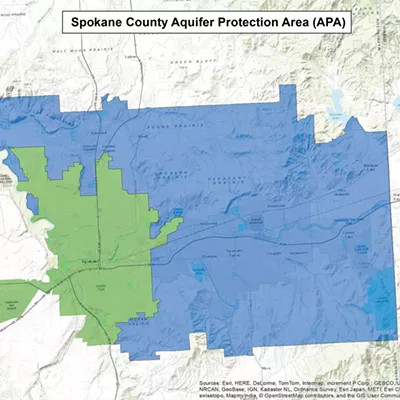
The smell of oil and metal wafts through the air in a shop-style classroom in east Spokane as students tinker with valves and pumps in preparation for an exam. A clang rings out as a part is accidentally dropped onto the concrete floor.
Instructor John Norman periodically walks around the room to individually administer the test to students who are ready. Their task: to demonstrate the proper assembly, functioning and dismantling of a valve stack, which allows hydraulic circuit function components to be mounted in a single package.
Easy, right?
Norman has been a technical education instructor at Spokane Community College for the better part of three decades, but his time at SCC goes beyond that. Norman teaches in the same program he graduated from — hydraulic and pneumatic automation, informally known as fluid power. He's one of two instructors in the program.
Norman has worked with up-and-coming trades workers for the last 28 years and says he has enjoyed every moment of it.
"I love what I do," Norman says emphatically. "I do it for people trying to better their lives. I do it for people like Serenity."
TERMS OF THE TRADES
HYDRAULIC Denoting, relating to or operated by a liquid moving in a confined space under pressure.
PNEUMATIC Containing or operated by air or gas under pressure.
AUTOMATION The use of largely automatic equipment in a system of manufacturing or other production process.
Serenity Haines is one of Norman's current students, and she's only a few weeks away from graduation. Haines says she's always been interested in hands-on work, but while growing up she'd actually imagined that she'd become an engineer.
Unfortunately, life had other ideas.
Most entry-level engineering jobs require a four-year degree, while other engineering roles require a graduate degree or other additional training. As a low-income, single mother, Haines didn't have the time or money to spend six years or more in college.
So instead, she enrolled in the hydraulic and pneumatic automation program at SCC, which promised to have her in a career in about two years' time. Some options might be in system design, plant maintenance and troubleshooting, or installation of automated machinery.
All she had to do was put in the work — which Norman says she's done more than her fair share of.
"I saw this program as a sort of entry into the industry where I want to get certified in the future," Haines says.
Now, as she approaches graduation, Haines has already signed a contract with a national company. While she couldn't disclose much about her next steps, she did say she's excited to spend the next few years learning on the job as much as possible.
Haines' success story isn't an unfamiliar one for those looking to work in the trades. Mechanics, plumbers, electricians and many other technical workers often have little to no school debt, earn salaries above the national average, and are secure in their positions, Norman says.
The college even has a waiting list of employers from across the country calling to find qualified workers, he says. By April or May, all the graduating students will have already been hired, he adds.
But even with the pitch of job security and higher wages, many trades are still worried about an increasing demand for their services while the current supply of qualified workers is fast-approaching retirement.
"In another 10 years it will be a nightmare," Norman says. "We will be having companies that are not able to perform or produce at the levels that are needed."
IMPERILED INDUSTRIES
Dirty jobs. Blue-collar jobs. Trade jobs. From the ancient Mesopotamians who built rudimentary sewer systems to the current aerospace machinists crafting our path to space and beyond, these jobs are essential to the world we live in.
However, fewer young people are stepping into these hands-on roles, and the current workforce continues to age. For example, the median age for farmers and ranchers is 56, and the median age for construction and building inspectors is 53, according to the U.S. Bureau of Labor Statistics. Comparatively, the median age for all jobs is 42, while jobs in the health care industry such as EMTs have a median age of about 31.
There are a few things that can be blamed for this downward trend, including less-than-favorable public perceptions of "dirty jobs," the push to encourage high schoolers to attend four-year universities and the COVID-19 pandemic.
"One of the things I have been working on is redefining the word 'blue-collar worker' because there is a lot of baggage that comes with the term, and people tend to turn their noses down at it," says Ashley Purdin, dean of technical education at Spokane Community College. "We're redefining them as crucial experts of indispensable industries."
Purdin thinks changing the narrative on the trades is the best way to get more people in those positions. That includes pushing back on the idea that a four-year degree is the best choice for a successful future.
"When I was growing up, we were told that we needed to get a four-year degree to be successful," SCC student and Spokane native Jon Smilden says. "There was this sense that we needed to get away from dirty jobs."
Smilden will graduate soon with an associate's degree and certifications in hydraulic and pneumatic automation. He already has two prospective jobs, and if all goes well, he'll be working in Chicago soon after graduation.
Norman believes the reason that four-year degrees are pushed so hard is because staff working in high schools are comfortable with the path they took themselves.
"They look at the trades as these 'dirty' jobs," Norman says, echoing Purdin.
If you ask Shannen Talbot, spokesperson for the Inland Northwest Associated General Contractors of America, the reason for the shortage of workers is more recent and a bit simpler.
Talbot points to work-from-home policies that have enticed workers in a post-pandemic world. While that might suffice for office workers whose entire day may be spent at a desk, trade workers just don't have that option.
"We're facing all the same problems that have been affecting other industries after the pandemic," she says. "We just don't have the flexibility to address them in the way other industries have."
Efforts to get more people interested in the trades have started to focus on educating the public about the variety of career paths out there.
"Many don't even know the opportunities that are available in these industries," Talbot says.
NEXT GENERATION
Earlier this month, hundreds of prospective students wandered around the SCC campus as they learned about the technical careers that are available to them during a "Future Sasquatch Day." After exploring all the possibilities, the prospective students got to home in on one or two programs of interest to learn more about. According to Purdin, this included hands-on activities meant to excite the students.
Purdin says more than 500 students attended the event, which is a larger turnout than they've seen before.
While the trades may seem to be in dire straits, Purdin believes we're seeing the beginning of an upward trend. Almost every program at SCC is full with enrolled students.
In the recent past, these programs usually had about six or seven students enrolled, but now, many have 20 students, plus more on the waiting list.
"Now I'm looking for funding to increase the size of them," Purdin says.
Current student Smilden says the popularity of the full electrical maintenance and automation program made him decide to go into the hydraulic program instead, rather than hop on the waiting list.
If Purdin is able to secure funding, she would be able to double the maximum enrollment in some of the programs at SCC and offer more choices.
"This gives our students and faculty something to look forward to," she says. "We're trying to make sure that these opportunities are open to everyone possible."
Even though interest in the trades seems to be trending upward, Purdin doesn't think that's cause to relax anytime soon.
"I literally have people beating down my doors to try and get somebody, anybody," she laughs. "They'll take anybody with a heartbeat at this point."
Norman shares a similar sentiment but thinks we need to learn to do more with fewer people involved. This means automating jobs that may have previously been done by one or more people.
This is something we've seen in the past decade with the introduction of things like self-checkout at grocery stores, but when it comes to technical work, he thinks automation can be done most efficiently in the manufacturing field.
"We would be able to fill this void that's coming with all the baby boomers retiring," he says.
Still, that wouldn't erase the need for workers in those fields. Someone needs to operate and maintain the automated systems, and Norman says that many other jobs are just too complicated to automate. ♦

























